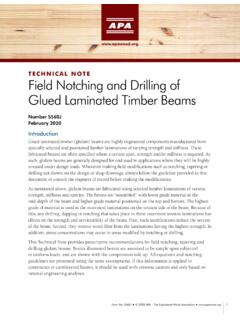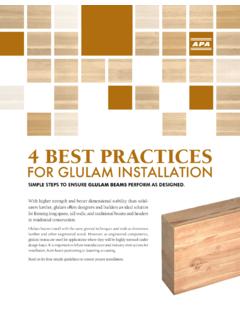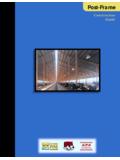Transcription of Technical Note: Preservative Treatment of Glued Laminated ...
1 Technical noTe Number S580D July 2013inTroducTionStructural Glued Laminated timbers ( glulam ) bearing the APA EWS trademark are produced by members of APA The Engineered Wood Association. These glulam timbers are manufactured to conform with ANSI Standard , American National Standard for Structural Glued Laminated Timber.(1)Although glulam does not require Preservative Treatment for most uses, certain applications may present environmental conditions conducive to decay, insect or marine borer attack, such as the long-term or frequent presence of moisture (generally 20 percent or greater moisture content of the wood) accompanied by temperatures ranging from 50 F to 90 F.
2 Decay slows at temperatures outside this range and virtually ceases at temperatures below 35 F or above 100 conducive to decay or insect attack are typically controlled through recognized design principles and construction techniques, such as use of overhangs, flashings, ventilation and proper joint connection details. When these conditions cannot be avoided, glulam must be pressure- Preservative -treated or a naturally durable wood species must be used. Examples of construction where such hazards may exist include direct exposure to weather, ground contact (including direct contact with concrete foundations and footings), contact with fresh water or sea water and exposure to excessive uses of Preservative -treated glulam include bridges, utility structures, marine applications, highway noise barriers and decks.
3 Indoor uses that may require pressure Treatment include environments subject to high humidity or condensation such as indoor swimming pools or greenhouses, where moisture content of the wood may exceed 20 percent. Indoor applications, such as post-frame construction in some agricultural buildings, may also involve ground contact, and thus require Preservative Treatment for those members in contact with the STandardSApplicable standards for Preservative Treatment of glulam include American Wood Protection Association (AWPA) Standards U1(2) (and all other standards referenced therein) and M4.
4 (3) Related specifications include National Design Specification for Wood Construction (NDS)(4); ANSI (1); and Standard Specification for Transportation Materials and Methods of Sampling and Testing.(5) Preservative Treatment of Glued Laminated TimberPreservative Treatment of Glued Laminated TimberForm No. EWS S580D 2013 APA The Engineered Wood Association end-uSe Service condiTionSThe American Wood Protection Association (AWPA) has replaced the Commodity (C) Standards with the Use Category System (UCS).
5 Service conditions are now designated into five basic use categories in AWPA Standard U1.(2) The use categories designations and service conditions that apply to glulam are summarized in Table that special attention should be paid when specifying Preservative treatments for use in areas subject to Formosan subterranean termite activities. For a list of suitable preservatives, please refer to AWPA Standard U1.(2) When specifying the use of Preservative -treated glulam in the state of Hawaii, confirm with city and county build-ing codes that the specified Preservative treatments meet the requirements for structural 1 SUMMARY OF USE CATEGORIES FOR TREATED WOODUse CategoryService Conditions Use EnvironmentCommon Agents of DeteriorationTypical ApplicationsUC1 Interior DryInterior construction, above ground.
6 DryContinuously protected from weather or other sources of moistureInsects onlyInterior construction and furnishingsUC2 Interior DampInterior construction, above ground, dampProtected from weather, but may be subject to sources of moistureDecay fungi and insectsInterior construction UC3A(a) Above Ground ProtectedExterior construction, above ground, coated and rapid water run-offExposed to all weather cycles, not exposed to prolonged wettingDecay fungi and insectsCoated millwork, siding and trimUC3B Above Ground ExposedExterior construction, above ground, uncoated or poor water run-offExposed to all weather cycles, including prolonged wetting Decay fungi and insectsDecking, deck joist, railings, fence pickets, uncoated millworkUC4A Ground Contact General UseGround contact or freshwater.
7 Non-critical componentsExposed to all weather cycles, normal exposure conditionsDecay fungi and insectsFence, deck and guardrail posts, cross-ties and utility poles (low decay areas)UC4B Ground Contact Heavy DutyGround contact or freshwater, critical components or difficult replacementExposed to all weather cycles, high decay potential includes saltwater splash Decay fungi and insects with increased potential for biodeteriorationPermanent wood foun-dations, building poles, horticultural posts, cross-ties and utility poles (high decay areas)
8 UC4C Ground Contact Extreme DutyGround contact or fresh- water, critical structural componentsExposed to all weather cycles, severe environ-ments, extreme decay potential Decay fungi and insects with extreme potential for biodeteriorationLand and freshwater piling, foundation piling, cross-ties and utility poles (severe decay areas)UC5A Marine Use Northern WatersSalt or brackish water and adjacent mud zoneNorthern watersContinuous marine exposure (saltwater)Saltwater organismsPiling, bulkheads, bracingUC5B Marine Use Central WatersSalt or brackish water and adjacent mud zoneNew Jersey to Georgia, south of San FranciscoContinuous marine exposure (saltwater)Saltwater organisms, including creosote tolerant Limnoria tripunctataPiling, bulkheads, bracingUC5C Marine Use Southern WatersSalt or brackish water and adjacent mud zoneSouth of Georgia, Gulf Coast, Hawaii and Puerto RicoContinuous marine exposure (saltwater)
9 Saltwater organisms, including creosote tolerant Martesia and SphaeromaPiling, bulkheads, bracing(a) UC3A is not covered in AWPA Standard U1 for Treatment of Glued Laminated TimberForm No. EWS S580D 2013 APA The Engineered Wood Association treatments listed in AWPA Standard U1(2) for glulam include creosote, pentachlorophenol, copper naphthenate, oxine copper and waterborne inorganics. Proprietary Preservative treatments that meet AWPA require-ments and local building department approvals are permitted for PreservativesOrganic preservatives listed in AWPA Standard U1 include creosote, penta chlorophenol, copper naphthenate and oxine copper.
10 The first two are restricted use chemicals and not available for residential construction. Creosote is a coal tar product which is dissolved in a distilled solution or petroleum oil. It is an effective Preservative in commercial, industrial or marine applications when there is severe exposure to decay or insect attack, or marine borers in saltwater environments. Creosote-treated glulam has an odor and a dark, oiled surface appearance and, therefore, is not recommended where painting is (penta) is commonly dissolved in light petroleum oil or solvent, liquid petroleum gas (LPG), or in a petroleum solvent/water solution.









